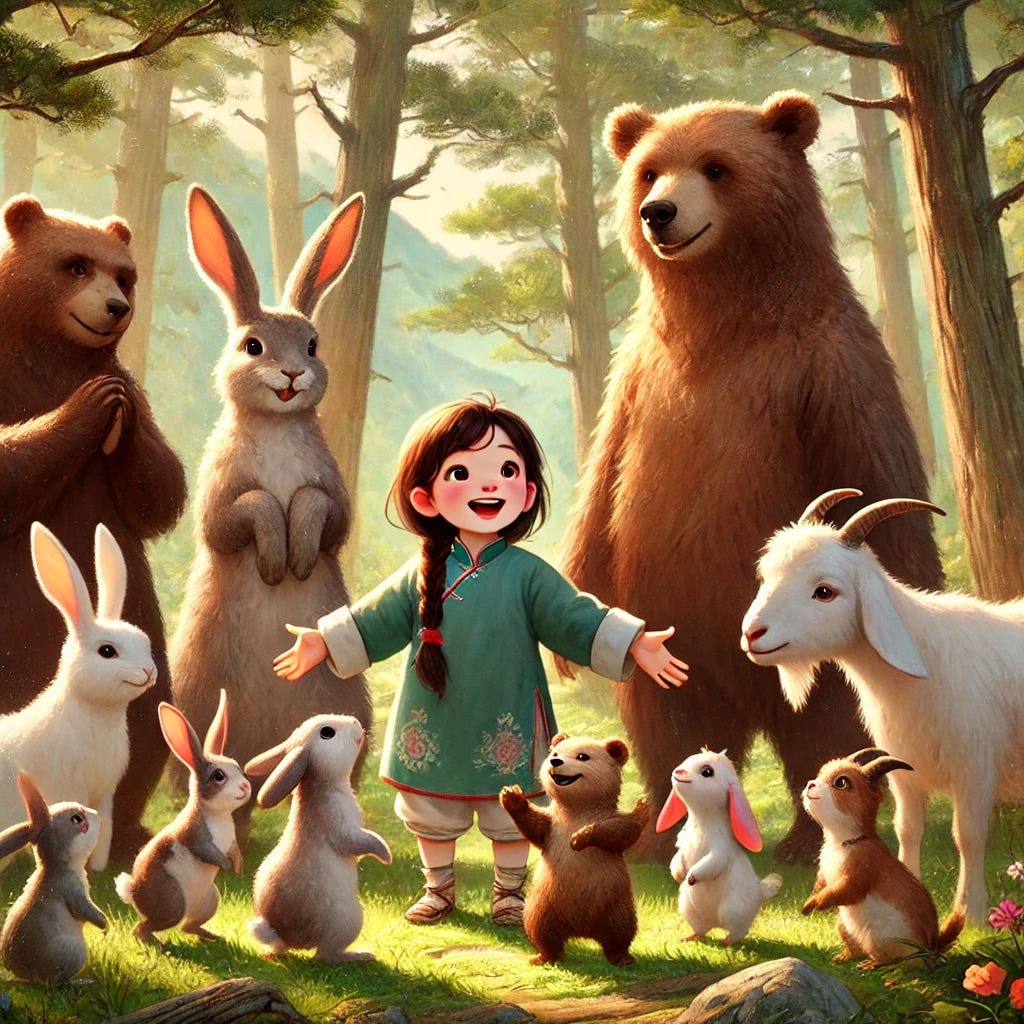A Story of Friendship and Imagination
In this beginner-friendly Mapping Mandarin™ story, two friends, 杜小默 (Dù Xiǎo Mò) and 阿绿 (Ā Lǜ), take turns crafting a whimsical tale using their toys as characters. Their impromptu tale follows 布布 (Bù Bù), a cloth doll, as she embarks on a journey through the forest, helping different animals find their lost children. With charming repetition and engaging dialogue, this story is perfect for learners building confidence in Chinese!
Join us in this fun storytelling adventure and see where imagination can take you! 🚀📖✨
两个朋友编故事
从前,有一位善良的小女孩,她的名字叫布布。
有一天,她来到了一片树林里。树林里不但有好多好多的树木,还有好多鲜花呢。有红色的海棠花,有紫色的金鱼草,有黄色的迎春花——
杜小默一边说着,一边拿着布娃娃。
她采着采着,突然看见一只身体一半胖一半瘦的老灰兔。她向老灰兔打招呼说:“你好哇!”
老灰兔说:“你好,我的孩子走丢了,你能帮我找到他吗?”
布布说:“可以呀!”
于是,布布就去帮老灰兔找孩子。
阿绿说着,让手里的兔子在桌上蹦来蹦去的,显出很着急的样子。
她找着找着,突然看见一头个子一半高一半矮的大黑熊。她向大黑熊打招呼说:“你好哇!”
大黑熊说:“你好,我的孩子走丢了,你能帮我找到他吗?”
布布说:“可以呀!”
于是,布布就去帮老灰兔和大黑熊找孩子。
杜小默讲到这儿时,脸上露出了微笑,她越讲越觉得有趣。
她找着找着,突然看见一只胡子一半长一半短的母山羊。她向母山羊打招呼说:“你好哇!”
母山羊说:“你好,我的孩子走丢了,你能帮我找到他吗?”
布布说:“可以呀!”
于是,布布就去帮老灰兔、大黑熊、和母山羊找孩子。
阿绿讲到这里时,想了想,接着讲下去。
她找哇找,找哇找。
她爬过一道山坡, 她越过一条小河,她走过一片田野, 终于,在一块空地上,她看见了小灰兔、小黑熊和小山羊。原来,他们正在那里玩捉迷藏呢。他们玩得忘记了时间,结果害得妈妈们找得好辛苦。
布布帮动物妈妈们找到了孩子,动物妈妈们都高兴极了,她们为布布送来了好多礼物,有蘑菇,有蜂蜜,有羊奶——
这可真是意外的惊喜,布布好开心啊!
听阿绿讲完了这个故事,杜小默兴奋地鼓起掌来,蹦跳着说:“你讲的结尾太棒了!”
Download the PDF file HERE.
These PDFs are designed to help you immerse yourself fully in the language, focusing on reading and comprehension without Pinyin or vocabulary lists. And they include both simplified and traditional character versions. You can download, print them out, and use them for study and review at your own pace.
📖本故事改编自《跟一半国说再见》,选自杜小默励志成长故事童话版,作者葛欣。
This story was adapted from 《跟一半国说再见》, selected from Du Xiaomo's inspirational growth story fairytale edition, written by Ge Xin.
编故事 (biān gù shì) – to make up a story, to create a story
从前 (cóng qián) – once upon a time, in the past
不但 (bù dàn) – not only
善良 (shàn liáng) – kind, kind-hearted
树林 (shù lín) – forest, woods
树木 (shù mù) – trees
鲜花 (xiān huā) – fresh flowers
海棠花 (hǎi táng huā) – crabapple flower
金鱼草 (jīn yú cǎo) – snapdragon
迎春花 (yíng chūn huā) – winter jasmine
布娃娃 (bù wá wa) – cloth doll
身体 (shēn tǐ) – body
一半 (yí bàn) – one half
胖 (pàng) – fat
瘦 (shòu) – thin
老灰兔 (lǎo huī tù) – old gray rabbit
打招呼 (dǎ zhāo hu) – to greet
孩子 (hái zi) – child
走丢 (zǒu diū) – to get lost
帮 (bāng) – to help
找到 (zhǎo dào) – to find
布布 (bù bù) – name of the cloth doll
让手里的兔子 (ràng shǒu lǐ de tù zi) – to make the rabbit in one’s hand do something (e.g., hop around)
蹦来蹦去 (bèng lái bèng qù) – to hop around
显出 (xiǎn chū) – to show, to reveal
着急 (zháo jí) – anxious, worried
的样子 (de yàng zi) – the appearance or manner of…
找着找着 (zhǎo zhe zhǎo zhe) – searching and searching, while continuing to search
个子 (gè zi) – height, stature
一半高一半矮 (yī bàn gāo yī bàn ǎi) – half tall and half short
大黑熊 (dà hēi xióng) – big black bear
走丢 (zǒu diū) – to get lost
帮 (bāng) – to help
露出 (lù chū) – to reveal, to show (See Footnote)
微笑 (wēi xiào) – a smile, a grin
脸上露出了微笑 (liǎn shàng lù chū le wēi xiào) – a smile appeared on (her) face越讲越觉得有趣 (yuè jiǎng yuè jué de yǒu qù) – the more (she) tells the story, the more interesting it becomes
Footnote:
露出 (lù chū) – While many modern elementary textbooks standardize this pronunciation as 露 lù, the variant 露 lòu is still heard in some regions or traditional usage. Both refer to the act of revealing or showing something, but 露 lù is now the officially taught form in standard Mandarin education.
母山羊 (mǔ shān yáng) – nanny goat
胡子 (hú zi) – beard, whiskers
一半 (yí bàn) – half
长 (cháng) – long
短 (duǎn) – short
于是 (yú shì) – so, as a result
讲到这里时 (jiǎng dào zhè lǐ shí) – when (she) got to this part of the story
接着 (jiē zhe) – to continue, to carry on
讲下去 (jiǎng xià qù) – to keep telling (a story)
找哇找 (zhǎo wa zhǎo) – searching and searching (repetitive and playful tone)
山坡 (shān pō) – a hillside
小河 (xiǎo hé) – a small river
田野 (tián yě) – fields, open countryside
空地 (kòng dì) – a clearing, open space
捉迷藏 (zhuō mí cáng) – hide-and-seek
忘记 (wàng jì) – to forget
结果 (jié guǒ) – as a result
害得 (hài de) – to cause someone to (negatively), ended up making someone...
辛苦 (xīn kǔ) – exhausting, hard (expressing someone has put a lot into something)
蘑菇 (mó gu) – mushrooms
蜂蜜 (fēng mì) – honey
羊奶 (yáng nǎi) – goat milk
意外 (yì wài) – unexpected
惊喜 (jīng xǐ) – pleasant surprise
开心 (kāi xīn) – to be happy, delighted
兴奋 (xīng fèn) – to be excited
鼓掌 (gǔ zhǎng) – to clap hands
蹦跳 (bèng tiào) – to hop, to bounce
结尾 (jié wěi) – an ending, conclusion
Let’s take a closer look.
The translation shows the characters followed by English, arranged by meaning.
她 (she) 找哇找 (searched and searched),找哇找 (searched and searched)。
她 (she) 爬过 (climbed over) 一道山坡 (a hillside),她 (she) 越过 (crossed over) 一条小河 (a small river),她 (she) 走过 (walked across) 一片田野 (a field),终于 (finally),在一块空地上 (at a clearing),她 (she) 看见了 (saw) 小灰兔 (the little gray rabbit)、小黑熊 (the little black bear) 和小山羊 (and the little goat)。原来 (it turned out) 他们 (they) 正在那里 (were right there) 玩捉迷藏 (playing hide-and-seek) 呢。
他们 (they) 玩得 (played so much they) 忘记了 (forgot) 时间 (the time),结果 (as a result) 害得 (caused) 妈妈们 (the mothers) 找得 (to search) 好辛苦 (with great difficulty).
布布 (Bù Bù) 帮动物妈妈们 (helped the animal mothers) 找到了孩子 (find their children),动物妈妈们 (the animal mothers) 都高兴极了 (were extremely happy),她们 (they) 为布布 (for Bù Bù) 送来了 (brought) 好多礼物 (many gifts),有蘑菇 (mushrooms),有蜂蜜 (honey),有羊奶 (goat’s milk)——
这可 (this really) 真是 (was truly) 意外的惊喜 (an unexpected surprise),布布 (Bù Bù) 好开心啊 (was so happy)!
听阿绿讲完了 (after listening to Ā Lǜ finish telling) 这个故事 (this story),杜小默 (Dù Xiǎo Mò) 兴奋地鼓起掌来 (excitedly applauded),蹦跳着说 (hopping and saying): f“你讲的结尾太棒了 (The ending you told was wonderful)!”
Character Radical
The radical 纟 (sī) is the simplified form of the traditional 糹, and it originates from the character 丝 meaning “silk.” This radical appears in many characters that are conceptually connected to threads, weaving, binding, and even textual continuity, making it one of the most fascinating and far-reaching radicals in the Chinese language.
Its connection to threads is both literal and metaphorical. In classical Chinese thought, threads represent connection, continuity, and even fate—as in the expression 千丝万缕 (qiān sī wàn lǚ), meaning "countless threads and ties."
Over time, 纟 evolved to represent not only physical threads but also written texts, relationships, and abstract bindings such as contracts or morals. Some scholars trace the use of this radical in words that appear frequently in classical literature and Confucian texts, especially in compound words that reflect order and tradition—key elements of classical Chinese ideology.
Examples from the story:
紅 (hóng) – red
綠 (lǜ) – green
紫 (zǐ) – purple
結 (jié) – to tie, to form (as in 結尾, the conclusion)
終 (zhōng) – end, death (as in 終於, finally or 結束, to finish)
Other examples:
絲 (sī) – silk (the full character form)
約 (yuē) – to make an appointment; an agreement (like 約會 for dates, or 預約 for appointments)
給 (gěi) – to give
線 (xiàn) – line, thread
經 (jīng) – classic, scripture (as in 經典)
Yin-yang Character Groups
Yin-yang character groups illustrate the balance and complementary nature of concepts in the Chinese language. Here are three pairs from the story:
高矮 (gāo ǎi) – Tall - Short
(出现在“大黑熊个子一半高一半矮”的描写中,反映出对比之美。)胖瘦 (pàng shòu) – Fat - Thin
(老灰兔身体“一半胖一半瘦”,体现身体的反差。)长短 (cháng duǎn) – Long - Short
(母山羊的胡子“一半长一半短”,呼应形象上的对立。)
Thanks for reading Mapping Mandarin™! I love doing this and want to keep all posts free for everyone. Please consider pledging to help keep them free. A yearly pledge or even a month now and then would be a great help. 感谢!
Also, check out my other Substack: Heart Of China Journal!
And the Master Mandarin YouTube channel!















